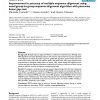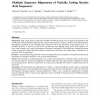939 search results - page 140 / 188 » A Case for Polyscopic Structuring of Information |
BMCBI
2008
13 years 9 months ago
2008
Background: A multiple sequence alignment (MSA) generated for a protein can be used to characterise residues by means of a statistical analysis of single columns. In addition to t...
BMCBI
2006
13 years 8 months ago
2006
Background: Multiple sequence alignment (MSA) is a useful tool in bioinformatics. Although many MSA algorithms have been developed, there is still room for improvement in accuracy...
CN
2006
13 years 8 months ago
2006
Overlay networks (proxy networks) have been used as a communication infrastructure to allow applications to communicate with users without revealing their IP addresses. Such proxy...
CE
2007
13 years 8 months ago
2007
The two separate projects described have examined how teachers exploit computer-based technologies in supporting learning of science at secondary level. This paper examines how pe...
BMCBI
2005
13 years 8 months ago
2005
Background: High quality sequence alignments of RNA and DNA sequences are an important prerequisite for the comparative analysis of genomic sequence data. Nucleic acid sequences, ...


